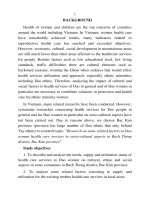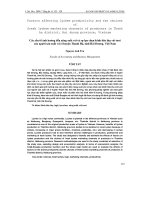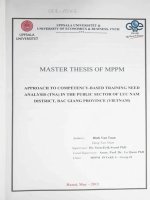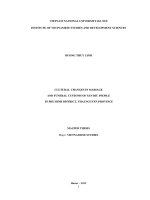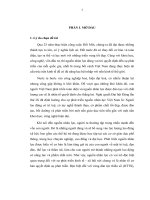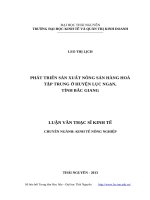Several factors affect the income of Hoa rural households in Luc Ngan district, Bac Giang province
Bạn đang xem bản rút gọn của tài liệu. Xem và tải ngay bản đầy đủ của tài liệu tại đây (898.37 KB, 5 trang )
KINH NGHIỆM THỰC TIỄN
SEVERAL FACTORS AFFECT THE INCOME OF HOA RURAL
HOUSEHOLDS IN LUC NGAN DISTRICT, BAC GIANG PROVINCE
Nguyen Thu Trang
Vietnam Academy for Ethnic Minorties
Email:
Received: 25/8/2019
Reviewed: 8/9/2019
Revised: 11/9/2019
Accepted: 25/9/2019
Released: 30/9/2019
DOI:
/>
T
he Hoa people are often given more attention because
of their success in the fields of commerce and services,
especially in developed economies, which have gradually become
solid financial solidarity. This paper aims to understand the
factors affecting the income of Hoa rural households in Luc Ngan
district, Bac Giang province - a locality with a total GDP of US
$1,540 in 2015. The analysis was collected in 2018 by the author
through a questionnaire survey of 250 Hoa rural households in
Luc Ngan district, Bac Giang province, Vietnam. The data after
processing by linear regression model shows that the income of
the Hoa people is affected by the area of perennial fruit land,
income from part-time jobs and the influence of cross-border
ethnic relations.
Keywords: Factors affecting income; Hoa rural households;
Luc Ngan district; Bac Giang province.
1. Introduction
Hoa people is one of 54 Vietnamese ethnic
groups. Over many different historical times, the Hoa
people have had strong changes in name, residence
area, living habits, livelihood characteristics. The
Hoa people have a highly developed business
operation, creating a business network not only
within Vietnam but also outside the territory of
Vietnam. They know how to organize wards,
societies and unions in business since they first set
foot in Vietnam.
Bac Giang is the province with the largest
number of Hoa people living in Northern Vietnam
(21,215 people). As of 2016, the population of Luc
Ngan district is 14,271 people. Tan Lap and Dong
Coc communes are two of the communes in Luc
Ngan district with the number of Hoa people living
at more than 1,000 people (Ethnic Committee of
Bac Giang province, 2016). After the Vietnam China border war event, the number of Hoa people
living in Bac Giang in particular as well as in many
other provinces in Vietnam decreased significantly.
However, over the past 10 years, the Hoa population
in Bac Giang has been constantly increasing.
Due to the dynamic nature of production and
business, quick adaptation to the market mechanism,
the economic business of Hoa people in Bac Giang
province is quite good, the average income per
capita is often 1.1 - 1.3 times higher than other
ethnic minorities, the rate of poor Hoa households
is lower than the average of other ethnic groups
in the same area. In addition to the production
of traditional local agricultural products such as
Volume 8, Issue 3
lychee, noodles, oranges, pineapples, apples, rice
cakes... Hoa people in Luc Ngan district also tend to
associate with Chinese traders who buy agricultural
products in Chu town or purchased at the garden.
In idle times, Hoa people in Luc Ngan district
travel to the Chinese border area with Lang Son to
work as hired labor to increase income. Therefore,
research to assess the influence of various factors
on the income of Hoa rural households in Luc Ngan
district, Bac Giang province is essential in the
current context.
2. Study overview
Up to now, there have been some typical
researches on Hoa people such as: Pham Dang
Hien (2000) with a brief scientific report Overview
of Hoa people in Luc Ngan district, Bac Giang
province; research project at grassroots level Family
worship of Hoa people in Luc Ngan district (Hien,
2005); Hoa people’s convergence history, cultural
characteristics and change in Cau Vong village
(Hỏi, 2015), Cross-border migration working issues
in Luc Ngan district, Bac Giang province (Trang,
2017).
The study of economic activity of Hoa people
in Vietnam in general and Hoa people in Bac Giang
province, including Luc Ngan district in particular,
is currently very little interest. Previous studies of
economic activity of the Hoa people were mainly in
the southern region, where this group of residents
resided in large numbers and concentrated in Ho
Chi Minh City, Dong Nai, Soc Trang and Kien
Giang provinces. However, the Hoa community in
the North is not separate from the Hoa community
141
KINH NGHIỆM THỰC TIỄN
living in Vietnam. In the context of socio-economic
development in the direction of strengthening the
solidarity relationship between peoples, promoting
the good cultural identities of each ethnic group,
demanding consider Hoa people’s livelihood issues
in the Northeast region, specifically Luc Ngan
district, Bac Giang province should be researched
like other ethnic groups in our country.
3. Research methods
This study uses a combination of qualitative
and quantitative methods; methods of summarizing
primary and secondary sources to ensure maximum
collection of information on factors affecting
income. Problematic case studies in the quantitative
analysis process are compensated for the lack of
necessary information by in-depth interviews.
Factors believed to have an impact on the income
of Hoa rural households in Luc Ngan district, Bac
Giang province are described through the following
diagram 1
Diagram 1: Model of factors affecting income of
Chinese rural households in Luc Ngan district, Bac
Giang province
The assumptions are that factors such as: the
area of fruit trees (AOFT), part-time job (PTJ),
cross-border ethnic relations (CBER), educational
attainment (EA) to varying degrees will all affect
the income of representatives of 250 Hoa rural
households in 2018 in Luc Ngan district, Bac Giang
province.
For each dependent variable, this study has
different ways of coding questions in order to
diversify information and handle quite abstract
variables such as “ethnic relations”.
The variable “cross-border ethnic relations”
currently has observed variables including: same
bloodline (SB), same family (SF), same hometown
(SH), same language (SL), and same customs (SC).
In order to verify the reliability of the scales, 30 test
questionnaires were verified through a measurement
formula using Cronbach’s Alpha coefficient (α = Nρ
/ [1 + ρ (N-1)]. The obtained results show that there
are no observed variables that need to be removed
because the result is > 0.3.
Table 1: Cronbach’s Alpha coefficient of the factor
142
in the Ethnic relations variable
Factor
Observed variables
Cronback’s Alpha if
item Deleted
SB
Same bloodline
0,612
SF
Same family
0,639
SH
Same hometown
0,703
SL
Same language
0,931
SC
Same customs
0,505
To continue looking at the relationships between
variables at all different factors in order to detect
observed variables that upload multiple factors or
observed variance variables from the outset, we
continue to analyze EFA discovery factor. The
results show that the KMO coefficient reaches
a value of 0.832 satisfying the condition of 0.5
≤ KMO ≤ 1, showing that the factor analysis is
accepted with the research data set. Sig Barlett’s
Test = 0.000 <0.05 also shows that factor analysis
is appropriate. Newly emerging factors include X1 ,
X2, D5, D6,
The survey results are processed on SPSS
22.0 software. Linear regression model is used to
calculate the impact level of factors:
The analytical model:
Y = B1X1 + B2X2 + B3D5 +B4D6
In which:
- The dependent variable Y is the choice of
training type.
- B1, B2, B3, B4, are standard Beta coefficients in
the multivariate regression equation.
- X1, X2, D5, D6, are new factors after the EFA
discovery factor analysis.
The multivariate regression equation in this
study did not use the standard regression equation
because only one independent variable (“ethnic
relations”) was changed, while the independent
variables remained the same.
The qualitative research was conducted by
in-depth interviews with heads of households
with typical developed economies and heads of
households with less developed economies. The
questionnaire in qualitative research was designed
100% as an open question, the content was fully
exploited information about the needs and types
of training for Hoa people in the area. In-depth
interviews take a minimum of 40 minutes. A total
of 5 interviews were conducted, then manually
removing the tape and recording the main contents
for analysis.
In Luc Ngan district, there are 2 communes,
Tan Lap and Dong Coc, with a population of over
3000 people. The total number of people answering
the question was 250 people, representing
250 households. The number of individuals
JOURNAL OF ETHNIC MINORITIES RESEARCH
KINH NGHIỆM THỰC TIỄN
participating in the content of the questionnaire
in the questionnaire of 1000 - 1300 people is said
to ensure the percentage of generalized research
content. The sex ratio in the questionnaire generated
by men / women reached: population / sample
for men was 68.1% / 67.4% and for women was
31.9% / 32.6%. Therefore, the study concludes
that the sample is representative. The results are
statistically significant to infer that the relationships
we discovered in this study are also included in the
population the study refers to.
4. Research results
The paper uses the ordinary least square method
(OLS) to estimate the linear regression model, in
order to identify factors affecting the income of Hoa
rural households in Luc Ngan district, Bac Giang
province. Estimated results are presented in Table 2
Table 2: Estimated results
Variable
Coefficent β
Value P
Constant C
13,185***
0,000
AOFT
1,478***
0,000
PTJ
2,001***
0,000
CBER
1,840***
0,000
EA
0,075***
0,000
Number of observations (N)
250
R2
0,4604
Modified R2
0,4521
Model verification value
0,0000
Note: (**): significant at 5%, (***): significant
at 1%, (*): significant at 10%.
The estimation results show that the model is
quite significant (> 1%) and points out many factors
that affect the income of Hoa rural households.
Among 4 variables: area of fruit trees, part-time
job, ethnic relations and educational attainment,
there are 3 variables: area of fruit trees, parttime job, ethnic relations receive values of more
than 1%, which have implications of a factor.
The educational attainment variable alone has no
value for Hoa people income here. This regression
model also explained 45.21% of the significance
of the variation of the independent variable to the
dependent variable.
The variable “area of fruit trees” reaches a
positive value of 1,478, which shows that the area
of fruit tree plantation of the household head has
a strong influence on the income of Chinese rural
households in Luc Ngan district. This is entirely
understandable when Luc Ngan district, from 1995
onwards, has always been the top country in lychee
production. This is considered a key crop in the
agricultural production of Northeast Vietnam. In
addition, in recent years, Hoa people have started
Volume 8, Issue 3
breeding many citrus varieties in other localities
to bring to Luc Ngan to grow such as grapefruit,
Cao Phong orange, yellow orange, Vinh orange,
tangerine and sapodilla... Hoa households in Luc
Ngan have a bigger area of fruit trees, the higher
their average annual income. “Fruit trees, for many
years, have helped us Hoa people to get out of
poverty” (IDI, male, 54 years old, 2018).
The “part-time job” variable, valued at 2,001
***, is the highest among the variables that affect
Hoa rural households income. The results of this
study indicate that Hoa people in Luc Ngan district
and many other ethnic groups living in the northern
border provinces of Vietnam have a relatively high
income compared to their income as hired laborers
across borders in many different forms. Through
brokers, relatives or people who have worked as
hired labor, many cross-border hired labor groups
have migrated to China. They work in many
different ways:
Source: Sociology survey of 250 Hoa
households, May 2018
Chart 1: Percentage of Hoa people participating in
jobs in China
“Compared to domestic labor, the current
income levels of cross-border migrant workers are
very attractive numbers. After each such hire, they
can earn 30 million to 40 million, enough to meet
many family spending needs. Many couples go with
their spouses. If they work hard, after a round of
cross-border labor like that, they can at least get 50
million dong. Meanwhile, if they only work as local
laborers or neighboring provinces in the country, at
the same time, they will only earn 20 million dong
at most.” (Results of IDI, Nguyen Thu Trang, 2019)
With such an attractive income, most Hoa
people often work as hired laborers after they have
finished harvesting the lychee, drying and selling
or storing them enough. Starting from August and
September until about the end of the Lunar New
Year, most of them migrate to China to work as
hired laborers at the end of the year. The income
level of part-time jobs has attracted most workers
here. However, it is worrying that these workers
migrate across borders mainly in the form of
illegal activities, posing a lot of risks.
The variable “ethnic relations” also has a β index
of 1,840 ***, a positive and relatively high index
143
KINH NGHIỆM THỰC TIỄN
to confirm that people who have the same ethnic
relations are more likely to migrate labor across
borders easier, find more jobs in China faster and
more safely during the labor process. According
to a study by Nguyen Thu Trang (2019), groups of
people working with cross-border ethnic relations
will have better living conditions, fewer wage losses
and less hard work, compared to unrelated, relative,
hometown labor with Chinese living across the border.
This is explained by the ethnic mentality of most
ethnic groups in Vietnam making the same choices in
similar circumstances. Stemming from the common
characteristics of anthropology, linguistic group, and
cultural practices lead to cultural “empathy” and the
tendency to form similar “common sense” groups. In
particular, for the Hoa ethnic group, having the same
relationship, the same hometown or the same cultural
practices will bring relationships to help each other
in the business. Stemming from the spirit of high
community cohesion, Hoa people will be able to
find jobs or higher incomes than other ethnic groups
working in China. This shows the great influence of
cross-border ethnic relations on Hoa people income
in Luc Ngan district, Bac Giang province.
The “educational attainment” variable in this
study alone has no effect on Hoa household income.
Most of the household heads have education levels
below college and university training. There are
many people who only finish primary school and
they don’t really care about the need for further
education. During the interview, they said, “I want
to let my children learn Chinese so later they could
be interpreters for Chinese traders or go to China to
work in companies” (IDI, female, 41 years old, 2018).
This confirms that the value of the “educational
attainment” variable is only 0.075 ***.
Thus, the income of Hoa rural households in Bac
Giang district, Luc Ngan province is influenced by
many factors, including area of fruit trees, income
from part-time jobs and benefits from crossborder ethnic relations. Unlike the results of many
other studies, the educational attainment of the
household head does not have a significant effect
on Hoa people income.
Many previous studies (Abdulai & CroleRees,
2001; Demurger et al., 2010; Janvry & Sadoulet,
2001; Klasen et al., 2013; Marsh et al., 2007; Yang,
2004; Yu & Zhu, 2013; Manjunatha et al., 2013)
all indicate that factors of area of fruit tree, income
from part-timejobs and benefits from cross-border
ethnic relations are factors that affect income of rural
households. However, contrary to the research of
Foster & Rosenzweig, (1996); Pitt & Sumodiningrat,
(1991); Yang (2004), the educational attainment in
this study had no effect on the income of Hoa rural
households. This can be explained by the cultural
characteristics and ethnic psychology of a relatively
specific ethnic group in Vietnam.
After important historical developments in
144
Vietnam-China relations, especially the 1979
border war, the majority of Hoa people in Northern
Vietnam, including Hoa people in Bac Giang, have
migrated to many other places to make a living,
forming immigrant waves of national scale. In
order to continue living, the Hoa group who stayed
in northern Vietnam was forced to change, a part
of them changing their names, seeking livelihoods
to adapt to the current situation. Up to now, Hoa
people still focus on business instead of education.
On the other hand, Hoa people have inherent knowhow in business, the community always helps each
other to develop the economy. With the psychology
of being away from home, due to the historical
background, the Hoa community, whether in the
North or the South, have a stronger connection than
other ethnic groups. This has created an effect in
raising the income of Hoa rural households in Luc
Ngan district, Bac Giang province in particular and
Hoa people in northern Vietnam in general.
The results of the study show that the Hoa
economy in Luc Ngan district, Bac Giang province,
is more developing, the average household income
is higher and more diverse than other ethnic
minorities living in the same area. However, to
further improve the economic life of the Hoa
community in Luc Ngan district, we propose some
solutions as follows:
Firstly, regarding the planning issue, it is
necessary to focus on developing ecological farms
combining tourism with agricultural development.
Areas where Hoa households grow fruit trees, raise
cattle and poultry should be invested in zoning
and piloting to build eco-farms, in order to attract
tourists.
Secondly, regarding the consumption of
agricultural products, it is necessary to have
practical plans and measures to help Hoa households
and other ethnic groups to consume agricultural
products after harvest, to avoid completely depend
on the Chinese market and the vicious cycle of
“bumper devaluation” as of today.
Thirdly, on the illegal migration activities of Hoa
workers, there is a need for strict management to
control the situation of migrant labor seeking jobs
on the other side of the border. In addition to strictly
controlling illegal border crossings, reducing risks
and social impacts from illegal migration to the
community. At the same time, increasing the career
change for domestic workers from agriculture
to non-agriculture. Encourage Hoa laborers to
participate in domestic employment, avoiding
wasting human resources.
5. Conclusion
The economic activity of Hoa people in Luc
Ngan district is not separate from the economic
development process of the whole Bac Giang
province. The Hoa community is also located in
JOURNAL OF ETHNIC MINORITIES RESEARCH
KINH NGHIỆM THỰC TIỄN
the center of the local fruit planning area, making a
positive contribution to the region’s agricultural and
handicraft production. Facing the strong impact of
science and technology and the increasing demands
of the market, the economic activities of the Chinese
community in particular and many other ethnic
groups in Luc Ngan in general need to be adapted.
References
Abdulai, A. & CroleRees, A. (2001).
Determinants of Income Diversification
amongst Rural Households in Southern
Mali. Food Policy, (26), 437–452.
Ethnic Committee of Bac Giang province.
(2014). Situation of working performance for
Hoa people in 2013, tasks in 2014. Report
No. 73/BC-BDT dated March 20, 2014.
Ethnic Committee of Bac Giang province. (2015).
Results of ethnic minority work performance
in 2015, tasks and measures implemented
in 2016. Report No. 139/BC-BDT dated
December 10, 2015.
Demurger, S., Fournier, M. & Yang, W. (2010).
Rural Households’ Decisions towards Income
Diversification: Evidence from a Township
in Northern China. China Economic Review,
(457), 1–13.
Ellis, F. (1998). Household Strategies and Rural
Livelihood Diversification in Developing
Countries.
Journal
of
Agricultural
Economics, 51(2), 289–301.
This study clarifies the different levels of
influence on income of Hoa rural housseholds in
Northern Vietnam, namely in Luc Ngan district, Bac
Giang province. This is also a new research direction,
many perspectives have not been fully exploited, it is
necessary to continue researching in the future.
Ellis, F. (2000). Rural Livelihoods and Diversity
in Developing Countries. Oxford: Oxford
University Press.
Foster, A. & Rosenzweig, M. (1996). Technical
Change and Human Capital Returns and
Investments: Evidence from the Green
Revolution. American Economic Review,
86(4), 931–953.
Trang, N. T. (2019). Hoạt động kinh tế của
người Hoa ở huyện Lục Ngạn, tỉnh Bắc
Giang. Luận án tiến sỹ Nhân học đã bảo vệ
cấp cơ sở tại Học viện Khoa học Xã hội.
Trang, N. T. (2019). Economic activity of Hoa
people in Luc Ngan district, Bac Giang
province. Doctoral thesis in Anthropology,
which defended at grassroots level at the
Graduate Academy of Social Sciences.
Manjunatha, A. V., Anik, A. R., Speelman, S.,
& Nuppenau, E. A., (2013). Impact of Land
Fragmentation, Farm Size, Land Ownership
and Crop Diversity on Profit and Efficiency
of Irrigated Farms in India. Land Use Policy,
(31), 397–405.
MỘT SỐ YẾU TỐ ẢNH HƯỞNG ĐẾN THU NHẬP CỦA NÔNG HỘ
NGƯỜI HOA Ở HUYỆN LỤC NGẠN, TỈNH BẮC GIANG
Nguyen Thu Trang
Học viện Dân tộc
Email:
Ngày nhận bài: 25/8/2019
Ngày gửi phản biện: 8/9/2019
Ngày tác giả sửa: 11/9/2019
Ngày duyệt đăng: 25/9/2019
Ngày phát hành: 30/9/2019
DOI:
/>
Volume 8, Issue 3
Abstract
Người Hoa thường được biết đến nhiều hơn bởi thành công
trong các lĩnh vực thương mại và dịch vụ, đặc biệt là ở những nền
kinh tế phát triển. Họ đã từng bước trở thành khối đoàn kết tài
chính vững chắc. Bài viết này nhằm tìm hiểu những yếu tố ảnh
hưởng đến thu nhập của nông hộ người Hoa sinh sống tại huyện
Lục Ngạn, tỉnh Bắc Giang - Một địa phương có tổng số GDP/người
năm 2015 đạt 1.540 USD. Số liệu dùng để phân tích được tác giả
thu thập trong năm 2018 thông qua việc điều tra bằng bảng hỏi đối
với 250 hộ gia đình người Hoa sinh sống tại huyện Lục Ngạn, tỉnh
Bắc Giang, Việt Nam. Số liệu sau khi xử lý bằng mô hình hồi quy
tuyến tính cho thấy thu nhập của người Hoa chịu tác động bởi diện
tích đất trồng cây ăn quả lâu năm, thu nhập từ việc làm thêm và ảnh
hưởng của quan hệ đồng tộc xuyên biên giới.
Keywords
Yếu tố ảnh hưởng đến thu nhập; Nông hộ người Hoa; Huyện
Lục Ngạn, tỉnh Bắc Giang.
145
